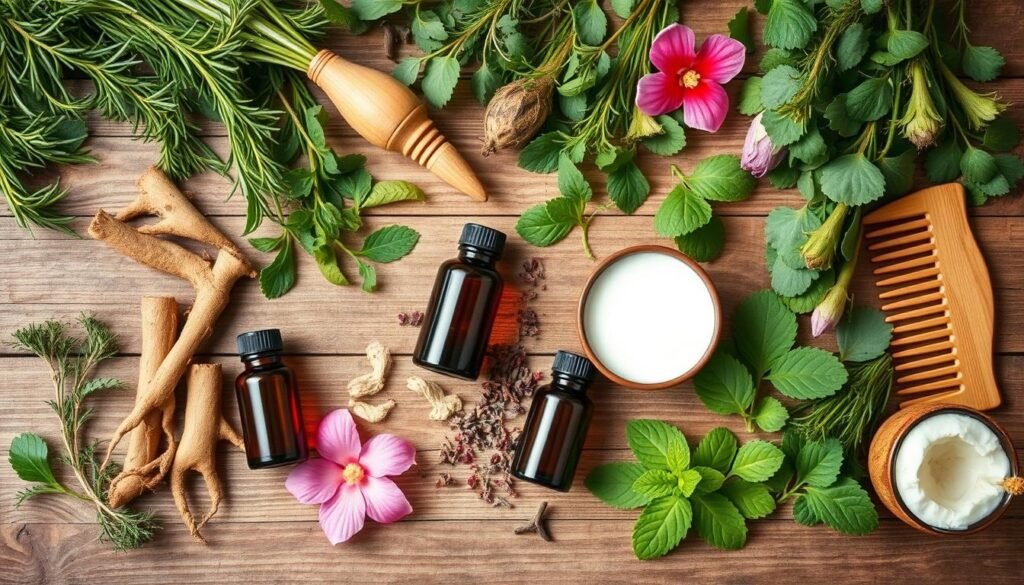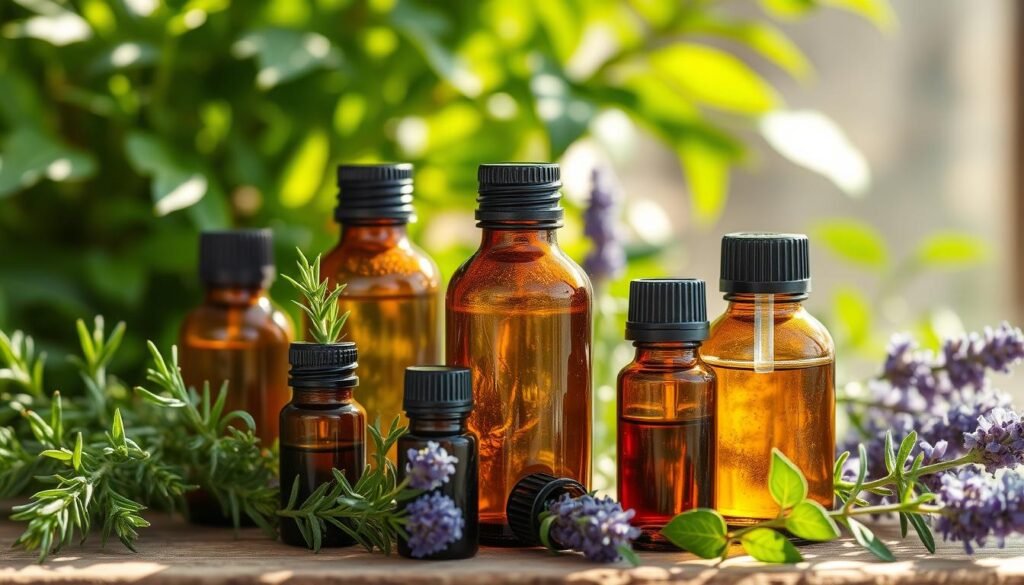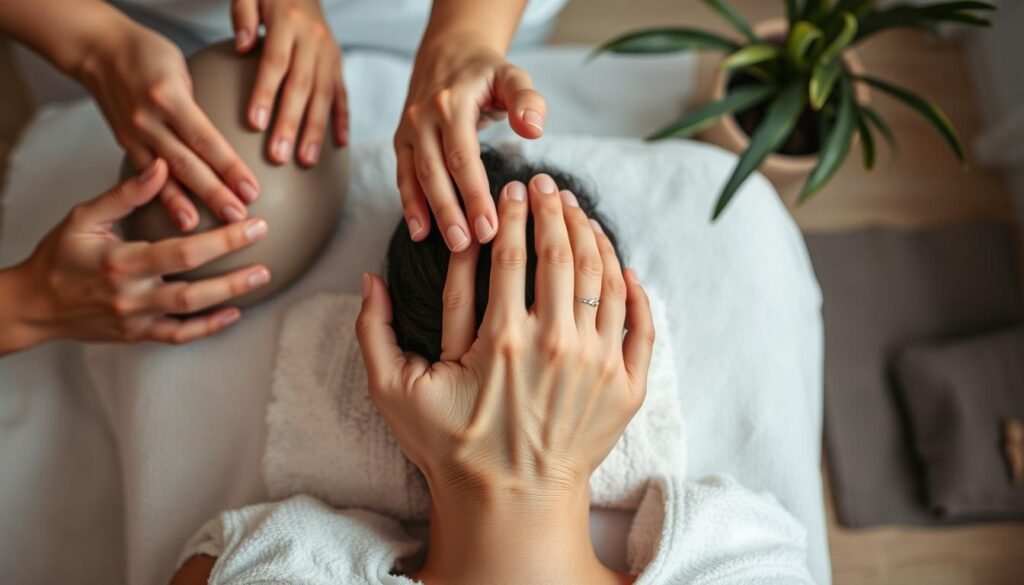Did you know that losing 50 to 100 hairs per day is normal? But if you’re losing more, it might mean your hair is thinning. Thinning hair can be worrisome, but it usually happens slowly. This gives you time to find out why it’s happening and how to fix it. You don’t have to spend a lot of money on treatments. There are many natural remedies you can try at home to help your hair grow back.
Several things can cause your hair to start thinning. This includes your genes, how you live your life, and how much stress you’re under. Using harsh products on your hair or wearing it in tight styles can make things worse. It’s important to look at everything that might be affecting your hair. This guide will show you how to change your diet, use herbal treatments, and care for your hair properly. All these can help you fight hair loss naturally.
Key Takeaways
- Common daily hair loss ranges from 50 to 100 strands.
- Genetics and lifestyle can significantly impact hair health.
- Natural remedies and dietary changes can promote hair regrowth.
- Effective scalp care improves blood flow, supporting healthier hair.
- Stress management is crucial in preventing hair loss.
Understanding Thinning Hairlines
Many people worry about their hairline getting thinner. This usually has to do with age and genes. Changes in the hairline can mean the start of conditions like alopecia, which has different forms. Knowing the causes of thinning hairline helps in finding good ways to manage and treat it.
What Causes Thinning Hairlines?
Genetics and the environment often cause a hairline to recede. Hormones, especially DHT, play a big role in male pattern baldness. They can disturb how hair grows. Studies show several main reasons:
- Genes affect chances of a hairline receding
- Hormones change during teen years and as people get older
- Smoking and life choices can stress the body
- Autoimmune diseases may lead to alopecia
- Too much hair styling and bad eating habits hurt hair health
Common Types of Hair Loss
Knowing the different types of hair loss guides choosing the right treatment. Here’s a list of common hair loss types:
| Type of Hair Loss | Description |
|---|---|
| Male Pattern Baldness | Marked by a hairline that moves back and thinning at the top, possibly leading to full baldness. |
| Female Pattern Baldness | Often means overall thinning, usually starting at the top. |
| Alopecia Areata | Leads to losing hair in patches. It can happen anywhere on the scalp. |
| Telogen Effluvium | This hair loss is often short-lived and can be caused by stress, medicines, or hormonal shifts. |
| Frontal Fibrosing Alopecia | This condition slowly causes loss of hair mainly at the front part of the scalp. |
Understanding these hair loss types allows people to look for specific treatments. They can also talk to skin doctors for plans to get their hair back.
Effective Dietary Approaches
A balanced diet is key to keeping your hair healthy. If you want to stop hair loss, focus on vital nutrients. These include vitamins and minerals that help your hair grow strong. Here are some important elements and tips to make your hair stronger.
Essential Nutrients for Healthy Hair Growth
Some vitamins are essential for hair to grow well. The most common deficiency worldwide is iron, which causes hair loss. Furthermore, about 80% of people losing hair lack vitamin D. This shows how important these vitamins are for your hair. Also, low zinc levels are often found in people with hair loss.
To encourage hair growth, eat foods rich in certain nutrients:
- Biotin – Essential for creating keratin, the main protein in hair.
- Iron – Helps carry oxygen to your hair roots.
- Zinc – Necessary for hair tissue to grow and heal.
- Vitamin A – Needed for cells to grow, which helps hair growth.
- Vitamin E – Protects your hair roots by fighting damage.
Include eggs, nuts, fatty fish, and leafy greens in your meals. Fatty fish, like salmon, have omega-3s that help your hair grow. Sweet potatoes are great too because they have beta-carotene. Your body turns it into vitamin A, which is good for your hair.
Benefits of the Mediterranean Diet
The Mediterranean diet is great because it focuses on whole foods. It includes vegetables, healthy fats, and protein. It’s useful if you’re looking for a diet to prevent hair loss. This diet is full of antioxidants that fight hair aging and loss.
This diet doesn’t just help your hair; it makes your whole body healthier. Studies show it can reduce inflammation. This is good for your hair. Eating this way can improve your vitamin and mineral intake, reduce harmful inflammation, and boost blood flow. This encourages your hair to grow healthier.
By focusing on the right diet, you can help your hair. Eating well can help fix thinning hair and encourage it to grow. You might also want to consider supplements if you’re not getting enough nutrients. If you’re interested, you can find more information through detailed studies on nutrients for hair.
Natural Herbal Treatments
Herbal remedies for hair loss are becoming more popular for their benefits in restoring hair. Choices like saw palmetto and ginseng stand out because they can help growth. Learning how to use these herbs can improve your hair care routine a lot.
Popular Herbs for Hair Regrowth
Saw palmetto is loved for its natural treatment of hair loss. It stops the effects of a hormone that causes hair to thin. This helps to stop more hair from falling out. Ginseng is known for increasing scalp blood circulation. This makes hair follicles healthier and strengthens hair growth.
How to Use Saw Palmetto and Ginseng
Adding herbal treatments into your daily life can show real changes. Saw palmetto works well as supplements or as an oil. These methods are known to help hair become thicker and fuller.
Ginseng helps hair grow when taken as capsules or tea. It’s a tasty way to improve hair health. Mixing these herbs with oil for scalp massages can also help by increasing nutrient absorption and blood circulation.

Using these natural herbs can be very helpful, especially for hair loss caused by the environment. For a deeper look at hair loss and treatments, check out more options here.
Essential Oils and Their Benefits
Adding essential oils to your hair care routine can boost hair growth and health. They are famous not just for smelling good but also for fighting hair loss. Studies pointed out oils like rosemary and peppermint as great for hair regrowth and a healthy scalp.
Top Essential Oils for Hair Growth
- Rosemary oil: Works as well as minoxidil in making hair thicker.
- Peppermint oil: Increases follicle count and growth, as shown in mouse studies.
- Cedarwood extract: Helps reduce hair loss and assist regrowth in alopecia sufferers.
- Lavender oil: Helps improve alopecia when used with other oils.
- Common sage: Could start hair growth by triggering certain cells.
- Lemongrass oil: Good for dandruff management.
- Tea tree oil: Battles dandruff and boosts scalp health.
- Ylang-ylang oil: Its anti-inflammatory and antioxidant properties are good for hair.
How to Apply Essential Oils Correctly
To use essential oils safely for hair, mix them with carrier oils like coconut or almond oil. This avoids skin irritation and adds extra nourishment to the scalp. Here’s how to apply the oils:
- Combine a few drops of essential oil with one ounce of carrier oil.
- Do a patch test to ensure no allergic reactions occur before using it fully.
- Massage the oil mix into your scalp, reaching the follicles deeply.
- Keep the oil in for at least 30 minutes, or overnight for more benefit.
- Wash out with a gentle shampoo after the waiting period.
Using essential oils regularly in your hair care can significantly improve hair thickness and growth. With time, these natural remedies hugely help with hair thinning.

| Essential Oil | Benefits | Study Findings |
|---|---|---|
| Rosemary Oil | Improves hair thickness | Comparable effectiveness to minoxidil |
| Peppermint Oil | Stimulates follicles | Increased growth noted in animal studies |
| Cedarwood Extract | Reduces hair loss | Promotes regrowth in alopecia areata cases |
| Lavender Oil | Enhances growth | Positive results with combination of other oils |
The Importance of Scalp Massage
Adding scalp massage techniques to daily routines helps those worried about hair thinning and loss. These methods often use fingers or special tools to gently press and rub the scalp. Doing this regularly can lead to healthier hair and a more relaxed feeling.
Techniques for Effective Scalp Massage
To get the most from benefits of scalp massage for hair, try these steps:
- Use your fingertips for soft, circular pressures.
- Try scalp massage brushes made for even results.
- Add essential oils for a better smell and effect.
For the best results, spend 10 to 20 minutes on this twice a day. This helps a lot in improving blood flow to scalp.
Benefits of Increased Blood Flow
Regular scalp massages boost blood flow to the scalp. This brings the nutrients needed for hair to grow. Men who did scalp massages for 24 weeks had thicker hair and better scalp health. Massaging the scalp stimulates cells affecting hair growth in many good ways.
Studies show hair growth techniques like these reduce hair loss. They also make the scalp healthier, hair shinier, and help with relaxation. For more details, check out this resource on scalp massage benefits.

Managing Stress Levels
Stress plays a big role in hair loss, making it important to manage stress for hair health. High stress can cause hair to fall out and slow down the growth of new hair. This is especially true in cases like telogen effluvium. We’ll look at how stress affects hair loss and ways to manage it.
How Stress Impacts Hair Loss
Stress and hair loss are closely linked. Chronic stress can cause inflammation around hair follicles, messing up the hair growth cycle. Conditions like telogen effluvium and alopecia areata show how stress leads to hair loss. Sometimes, the immune system attacks hair follicles, creating bald spots. In severe cases, stress can make someone want to pull their hair out.
Normally, people lose between 50 to 100 hairs a day. But stress can increase this, causing up to 300 strands to fall daily. It’s important to find and address the cause of the hair loss in stress-related cases.
Effective Stress Management Techniques
Using relaxation methods can greatly help manage stress for better hair health. Techniques include:
- Yoga: Certain poses increase blood flow to the scalp.
- Meditation: Calms the mind and lowers anxiety.
- Physical exercise: Helps with overall health and hair growth.
- Scalp massage: Boosts blood flow to the hair follicles.
Having a routine that includes these activities can reduce anxiety and help hair grow back. Being outside, enjoying hobbies, and talking about feelings with someone you trust also help manage stress.
| Relaxation Technique | Benefits |
|---|---|
| Yoga | Improves blood flow to the scalp |
| Meditation | Reduces cortisol levels |
| Exercise | Enhances overall well-being |
| Scalp Massage | Stimulates hair follicle activity |
Thinning Hairline: Hair Care Practices to Adopt
A good hair care routine is key for thinning hairlines. It’s important to choose the right shampoos to prevent more thinning. Look for products without harsh chemicals. These can weaken hair. Instead, go for those labeled as sulfate-free and paraben-free. This helps keep the scalp healthy.
Shampoos to Choose and Avoid
Here are some tips for picking shampoos:
- Sulfate-free: These gentle cleansers protect your hair.
- Natural ingredients: Look for things like biotin, caffeine, and oils.
- Avoiding harsh chemicals: Stay away from alcohol, parabens, and strong fragrances.
Selecting wisely can improve hair thickness and quality over time.
Impact of Hairstyles on Hair Loss
Hairstyles really affect hair health. Styles that pull tightly on the scalp, like braids and ponytails, can cause traction alopecia. Opting for looser styles can lessen damage. It’s also good to change up your hairstyle often. This avoids putting constant stress on your hair.
Adding these hair care steps and choosing hairstyles wisely can help you get healthier hair. Using the right shampoos and styling carefully, you can improve your hair’s look and feel more confident.
Exploring DHT Blockers
Dihydrotestosterone, or DHT, is a key factor in hair loss, especially for those with a genetic link to baldness. Learning how DHT blockers work is a step towards better hair. For those fighting hair loss, these blockers are a big help.
What Are DHT Blockers?
DHT blockers tackle hair loss by stopping DHT from harming hair roots. They work by keeping testosterone from turning into DHT. This could make hair fuller and thicker. You can choose from medicines or natural options like saw palmetto and pumpkin seed oil. These natural blockers offer a gentle way to fight hair loss and improve hair health.
Examples of Foods to Lower DHT Levels
To lower DHT, add certain foods to your diet. They help fight DHT from within.
- Green tea – Its antioxidants may reduce DHT formation.
- Turmeric – With its anti-inflammatory qualities, it’s a natural DHT blocker.
- Nuts – Walnuts and almonds are great for the scalp.
Eating these foods can help combat hair thinning. They support healthier hair growth by dealing with DHT effects on hair roots.
Conclusion
Stopping and reversing a thinning hairline naturally takes a whole-person approach. This includes eating right, using herbal remedies, managing stress, and caring for your hair the right way. By trying the natural solutions for thinning hairlines mentioned here, you can better your hair health and feel more confident. Eating foods full of vitamins and minerals is key for hair growth, and might help with genetic hair loss too.
Eating a Mediterranean diet helps too, because it’s packed with things that fight oxidation and inflammation, helping your hair stay healthy. While some people choose hair transplants or platelet-rich plasma (PRP) treatments, many prefer natural ways through lifestyle and habits to reverse hair loss. Understanding the deep-rooted issues that affect hair health, like stress and not getting enough nutrients, is critical as well.
A well-rounded plan can fight hair loss and boost your confidence. For those wanting more information on how diet affects hair loss treatment, there’s extensive info available. By embracing these changes, you can see great improvement in your hair health.
Explore the relationship between diet and alopecia treatment